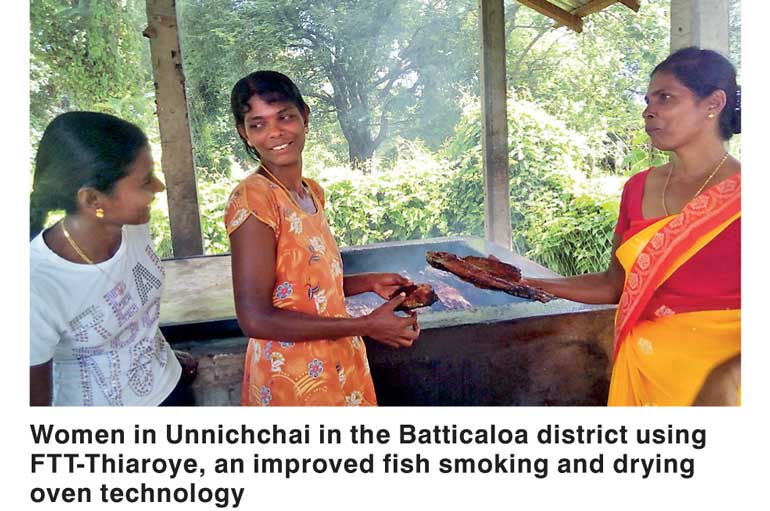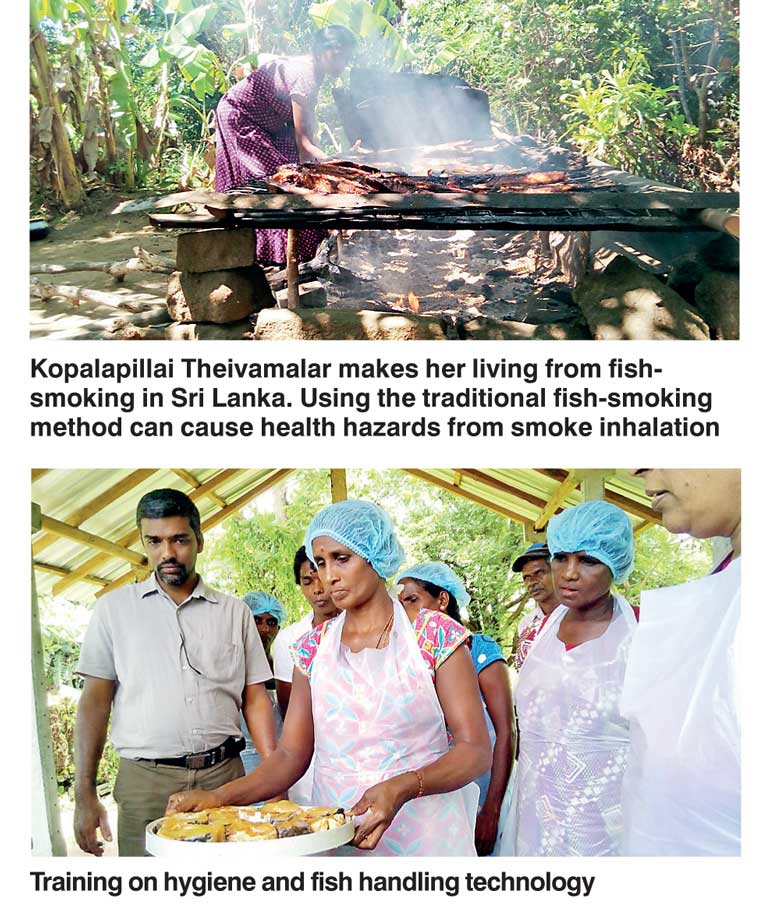Monday Nov 25, 2024
Monday Nov 25, 2024
Friday, 8 December 2017 00:00 - - {{hitsCtrl.values.hits}}


The traditional method of fish-smoking in Unnichchai, a small fishing community in the Batticaloa district sees women spending many hours tending to fish laid out on mesh over smoking coals. Health hazards from smoke inhalation are high, while the output from such intensive labour is often low. That is now changing with the introduction of new smoking ovens pioneered by the Food and Agriculture Organization of the United Nations (FAO) under a programme funded by the European Union (EU).
“The first thing I noticed was that the new technology helps me save time,” said Kopalapillai Theivarmallar who makes her living from fish-smoking to provide for her three daughters. “Before, I spent a total of 12 hours on two consecutive days drying and smoking the fish, and I used the old method of iron mesh. Now, six to seven hours are enough to finish one smoking. It gives me plenty of time to take care of my children and do household chores,” she said.
Since 2008 FAO has worked on developing the FTT-Thiaroye, an improved fish smoking and drying oven technology. The oven can be purpose built, or the smoke-capturing chimney, oil-catching trays and other elements can be added to an existing oven. It is designed to improve fuel-efficiency in fish-smoking by encapsulating heat and smoke. It also addresses health hazards suffered by small-scale fish dryers – the vast majority of whom are women.
In the Batticaloa District, around 150 families are engaged in fish-smoking activities. The traditional smoking method is done in the open, making the fish prone to spoilage from rain and external contamination. Strong winds can lengthen the process and often results in lesser-quality fish that sell at lower prices.
“With the method of iron mesh, our smoked fish is of poor quality, they are sold at 600 to 750 rupees per kilo. This is a very low price. The money we earn is not even enough to send our children to school,” said Fransis Devamalar, a fish smoker who heads her family of four children.
The FAO technology was first introduced in Africa, where 12 countries have now adopted it. Women using old methods of fish-smoking over an open fire often suffer eye and skin irritations and respiratory disease from the smoke. However, African women who have adopted the new method have improved their health, significantly increased their income, reduced their costs, cut down on losses, improved the quality and safety of their smoked fish, and were able to improve their family’s food security and nutrition.
In June this year, FAO with the European Union Support to District Development Programme (EU-SDDP) introduced the new smoking technology to Asia for the first time, starting with Sri Lanka where fish is a major source of livelihoods and nutrition.
“Introducing the new ovens will help to make the fish value chain in Sri Lanka more productive and profitable for the poorest families,” said FAO’s Representative in Sri Lanka Nina Brandstrup. “We are planning to support the introduction of the new technology in other parts of the country,” she said. This requires guidelines to be prepared in local languages and disseminated, and extension workers trained to advise communities on the construction and use of the ovens.
Constructing the first oven with a shed for processing space in Unnichchai cost around Rs. 227,000 – relatively expensive for small-scale fishing communities. However, the oven is shared among many families and expanding it to other communities will likely rely on micro-finance support from the government, development institutions, NGOs or the private sector.
For Kopalapillai Theivamalar, she is already seeing the benefits. ‘Before, I could only process 16 to 40 kilos of fish per day, but with the new ovens I can smoke 100 kilos per day. Also, the firewood needed is cheaper.” Theivamalar is now able to sell the smoked fish at 1100 rupees per kilo due to the improved product quality.
An additional eight ovens are in the process of being constructed under the EU-SDDP project in Sri Lanka. “This is a good entry point to the Asian continent which produces close to half the world’s smoked fish,” explained Yvette Diei Ouadi, the FAO Fishery Officer who coordinates the programme.
The FTT pilot unit established in June 2017 in Batticaloa has demonstrated the potential for improving product quality, reducing post-harvest losses, and environmental issues. FAO Sri Lanka jointly with the Government of Sri Lanka foresees a wider scale initiative that mainstreams the FTT for improved livelihood and food security.
Jointly implemented by five agencies of the United Nations namely FAO, UNDP, UNICEF, UNOPS, and ILO, and IFC from the World Bank Group, the EU-SDDP is a European Union-funded development cooperation programme with a total financial grant support of EUR 60 million. Its objective is to contribute to poverty reduction and livelihood development in seven districts in the North and East to bridge the socio-economic gap with the rest of the country. The programme supports the conflict-affected districts of Batticaloa, Mannar, Vavuniya, Ampara, Monaragala, Anuradhapura and Puttalam impacting half a million people.